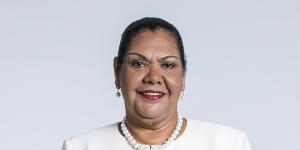That’s the message from June Oscar,the Aboriginal and Torres Strait Islander Commissioner and the co-chair of the annual Close the Gap campaign.

Aboriginal and Torres Strait Islander Social Justice Commissioner June Oscar.Australian Human Rights Commission
The pandemic and the bushfires of 2020 reinforced the need for large-scale reform and “a paradigm shift to truly empower Aboriginal and Torres Strait Islander peoples”,Ms Oscar said.
The campaign’s report – its annual response to the government’s progress – says “the biggest killer of Aboriginal and Torres Strait Islander people” was the ongoing struggle for equality and cultural recognition. This exacerbated mental health problems,contributed to high rates of chronic disease and manifested in suicide rates twice as high as in the non-Indigenous community.
It makes 15 recommendations,including the urgent adoption of the Uluru Statement of the Heart and increased investment in Indigenous health.
Following three Aboriginal deaths in custody this month,it says the over-incarceration of children and adults and disproportionately high rates of suicide is a source of ongoing trauma. It calls for the age of criminality for children to be raised across Australia from 10 to 14 years.
Speaking on Close the Gap day on Thursday,Ms Oscar said when the pandemic began,Australian governments “finally put their trust in local insights and expertise to keep our people healthy”.
“As we have all said,time and again,we know what is best for our own health and wellbeing ... When control is in our hands,when we can exercise autonomy,we succeed.”
Experts feared COVID-19 could have been disastrous for Indigenous communities because of overcrowding,existing chronic diseases and poor infrastructure.
Chief executive of the Kimberley Aboriginal Medical Service Vicki O’Donnell said avoiding COVID-19 deaths was a triumph.
“Our mob live together,eat together,work together,they kiss and they hug – so the spread was a huge risk for us.
“No Aboriginal person died. Does that not tell you something about what we do?” she said.
In 2019,suicide was the biggest killer of Aboriginal and Torres Strait Islander children aged five to 17 years. Suicide rates among adults are at least two to three times higher than for non-Indigenous Australians.
Yet the lack of resources and funding to train Aboriginal people in mental health and suicide prevention was “incredibly frustrating” for Thomas Brideson,the chief executive of Gayaa Dhuwi (Proud Spirit) Australia,a newly established Aboriginal and Torres Strait Islander mental health and suicide prevention organisation.
‘No Aboriginal person died. Does that not tell you something about what we do?’
Vicki O’Donnell
With more Indigenous staff,he hoped that Aboriginal people could seek help early rather than end up in acute hospital care at three times the rate of non-Indigenous people.
Mr Brideson,a deputy commissioner with NSW Mental Health Commission,said services,universities and professions weren’t training people who were equipped to deal with the complex needs of the Indigenous community.
“They should be more accountable,” he said. “If they can’t deal with people with complex needs,they are not competent. Let’s call it what it is. Surely we can do better?” he said.
What’s not improving
Info:Close the Gap report 2021
Many solutions to ongoing problems had been well documented,said Mr Brideson,pointing to the 339 recommendations of the 1991 report by the Royal Commission into 99 deaths in custody.
Few of these had been fully implemented.
The royal commission found 43 out of the 99 Indigenous people who died had been removed from their natural families,43 had been charged with an offence by the time they turned 16,only two had completed secondary schooling and 43 had been taken into custody at some stage relating to the over-use of alcohol.
Lifeline:13 11 14.
Start your day informed
Our Morning Edition newsletter is a curated guide to the most important and interesting stories,analysis and insights. Sign up toThe Sydney Morning Herald’s newsletterhere,The Age’shere,Brisbane Times’here,andWAtoday’shere.